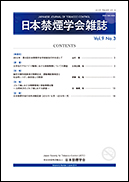Purpose: The aim of this study was to gather basic information to effectively provide smoking guidance to pregnant women who smoke by investigating the smoking status and awareness of pregnant women and families living together.
Method: A self-administered questionnaire survey was conducted with 636 pregnant women with average age of 30.7 years who visited our hospital between 2013 and 2015, which included questions on smoking status and awareness. Results: Pregnant women's smoking rate was 5.0%, and the smoking prevalence of those in their 10s was particularly high (45.5%). The proportion of pregnant women who were exposed to second-hand smoking was 46.2%. Most stages for quitting smoking in pregnant women were the preparation stages. The Kano Test for Social Nicotine Dependence (KTSND) score in the group of women with smoking husbands was significantly higher than in those with non-smoking husbands (p < 0.01). Following an antitobacco lecture, the KTSND scores significantly decreased (ex-smokers and non-smokers: p < 0.05, smokers: p < 0.01).
Discussion: Based on the KTSND score, it is inferred that the smoking behavior of pregnant women’s husbands influence pregnant women's intentions and behaviors to tolerate smoking. The decreases in KTSND score after the lecture suggests that such awareness-based education is useful for pregnant women.
Conclusion: When conducting smoking cessation guidance programs for pregnant women, it is necessary to include families.
View full abstract
